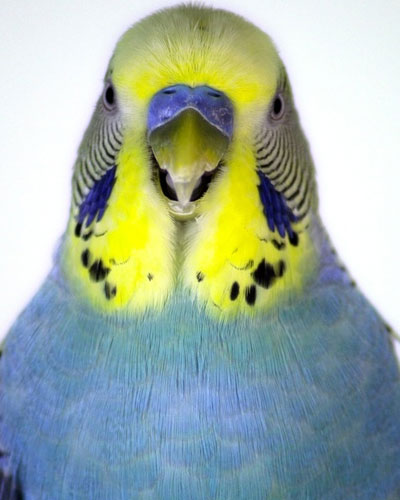Apparently, parrots aren’t just smart, they’re competitive too. A couple of months ago, we covered recent research findings on contagious yawning in animals, reporting on the rarity of the phenomenon and its potential role as a form of social mimicry or even an indication of empathy. While certain primates clearly do yawn contagiously and dogs may yawn contagiously, the behavior hadn’t been reported in other animals and had been expressly ruled out in red-footed tortoises (although the tortoises may have had the last laugh, as they won the celebrated Ig Nobel Prize for their non-yawns).
Word of our mammal-centric coverage seems to have reached the small, oval ears of the always-influential parrot lobby, though, as just last week the journal Behavioural Processes published a study describing social yawning in budgerigars (Melopsittacus undulatus), the small Australian parrot often referred to as the parakeet. This study provides the first support for contagious yawning in a non-mammal, and even ups the ante by documenting what may be the first instance of contagious stretching, another stereotyped behavior that may play a social role for certain animals. Some may say that the paper’s timing is an utter coincidence and that only someone with delusions of grandeur would believe that it was even remotely linked to the AnimalWise post. We, speaking in our usual royal manner, prefer to think otherwise.
Michael Miller, Andrew Gallup and other researchers from the University of the Binghamton conducted an observational study of yawning and stretching in a group of approximately 20 adult male and female budgerigars living together in an aviary as an established flock. Over a period of about a year and a half, the research team video recorded the flock on 23 separate occasions. The recording sessions, each of which lasted 90 minutes, were conducted at varying times of the day, and the researchers took a number of precautions (such as ignoring the first 15 minutes of each tape) to ensure that the flock’s behavior was as natural and undisturbed as possible. Trained reviewers then systematically reviewed all of the tapes, recording the time and occurrence of each yawn and stretch, and categorizing each stretch by whether the bird extended one or both legs.
The researchers’ hypothesis was that, if yawning and stretching were spreading contagiously among the birds, the behaviors would occur in nonrandom “clumps” – that is, rather than being evenly dispersed throughout the recording sessions, multiple yawns (or multiple stretches of the same type) would take place in closely-spaced bouts and then be followed by a long interval until a new priming behavior triggered another bout. Further, they predicted that, although there might be might be overall tendencies tied to particular times of the day (for example, the budgerigars might, on average, yawn more frequently during evening sessions), if the yawning and stretching really were being triggered contagiously, then specific clumping patterns would not repeat themselves when multiple same-time-of-day sessions were compared.
To test their hypotheses, the researchers performed detailed, session-by-session analyses of each type of behavior. For example, they tallied how frequently each behavior occurred, measured the time between adjacent stretches and yawns, and sorted the adjacent pairs into different “bins” depending on the length of the interval. They also analyzed each session for clumping by breaking it down into a large number of short (20 to 30 second) intervals, which allowed them to identify “runs” of consecutive intervals that either did, or did not, contain the behavior in question. Finally, they statistically analyzed their data in a variety of ways to identify patterns and associations.
And the results?
Both yawning and stretching behaviors were indeed clustered within trials, and the period between adjacent yawns and stretches was “strongly biased toward very short (< 20 sec) and very long (> 300 sec) intervals,” especially for the yawns. Also, as hypothesized, despite the clustering for both behaviors, “neither behavior routinely occurred at specific times from the start of a session across multiple recordings at the same time of day. This suggests that the clumping of these behaviors was due to social influences, and not to underlying physiological effects as a result of similar circadian patterns.”
The research team summarized its findings and suggested directions for future investigation as follows:
The observational results presented here suggest that yawning and stretching are at least mildly contagious in budgerigars under semi-natural flock-living conditions. In line with each behavior’s presumed physiological function, contagious yawning and stretching may ultimately coordinate mental state and a group’s collective movements, but future research needs to test these predictions.
So, kudos to the budgerigars! Parrots everywhere can take pride in these findings, which point to previously-unknown areas of avian social signaling and coordination, and which may open up new avenues for studying collective behavior.
_____
![]() Miller, M., Gallup, A., Vogel, A., Vicario, S., & Clark, A. (2011). Evidence for contagious behaviors in budgerigars (Melopsittacus undulatus): An observational study of yawning and stretching Behavioural Processes DOI: 10.1016/j.beproc.2011.12.012.
Miller, M., Gallup, A., Vogel, A., Vicario, S., & Clark, A. (2011). Evidence for contagious behaviors in budgerigars (Melopsittacus undulatus): An observational study of yawning and stretching Behavioural Processes DOI: 10.1016/j.beproc.2011.12.012.


